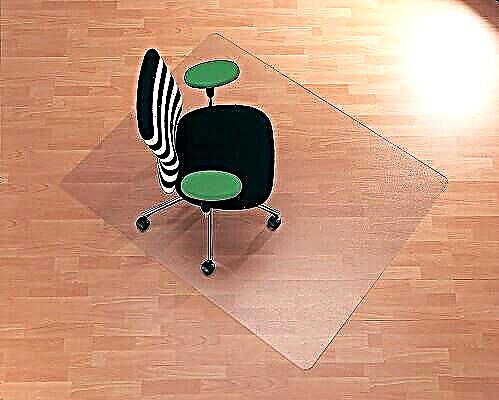1 DEVELOPED by the Federal state institution "Research Center" PROTECTION "of the Ministry of Internal Affairs of the Russian Federation (PKU SIC" PROTECTION "of the Ministry of Internal Affairs of Russia)
2 INTRODUCED by the Technical Committee for Standardization of TC 234 "Alarm systems and anti-criminal protection"
4 FIRST TIME INTRODUCED
5 REPUBLICATION. June 2019
The rules for the application of this standard are established in Article 26 of the Federal Law of June 29, 2015 N 162-ФЗ "On Standardization in the Russian Federation". Information on amendments to this standard is published in the annual (as of January 1 of the current year) information index "National Standards", and the official text of the amendments and amendments is published in the monthly published information index "National Standards". In case of revision (replacement) or cancellation of this standard, the corresponding notification will be published in the next issue of the monthly national index "National Standards". Relevant information, notification and texts are also posted in the public information system - on the official website of the Federal Agency for Technical Regulation and Metrology for Standardization on the Internet (www.gost.ru)
1 area of use
This standard applies to fences designed to protect the perimeter of a protected facility.
This Standard establishes the classification and general provisions regarding requirements for the design of protective fences (hereinafter - fences) installed in various climatic zones of the Russian Federation.
The requirements of this standard do not apply to fences designed to ensure the protection of military and defense facilities, federal state power and management, environmentally hazardous industries and trades, nuclear and radiation hazardous facilities, strategic (mobilization) reserve and life support, thermal and hydropower facilities subject to protection and defense.
2 Normative references
This standard uses normative references to the following standards:
GOST 15150 Machines, devices and other technical products. Versions for different climatic regions. Categories, operating conditions, storage and transportation regarding the impact of climatic environmental factors
GOST R 12.4.026 Occupational safety standards system. Colors are signal, safety signs and signal marking. Appointments and rules of use. General specifications and specifications. Test methods
Note - When using this standard, it is advisable to check the validity of reference standards in the public information system - on the official website of the Federal Agency for Technical Regulation and Metrology on the Internet or on the annual information index "National Standards", which was published as of January 1 of this year, and on the issues of the monthly information index "National Standards" for the current year. If the reference standard to which an undated reference is given is replaced, then it is recommended to use the current version of this standard, taking into account all the changes made to this version. If the reference standard to which the dated reference is given is replaced, then it is recommended to use a version of this standard with the above year of approval (adoption). If, after the adoption of this standard, a change has been made to the referenced referenced standard that affects the referenced provision, then this provision is recommended to be applied without regard to this change. If the reference standard is canceled without replacement, the provision in which the reference to it is given is recommended to be applied in the part that does not affect this reference.
3 Terms and definitions
The following terms are used in this Standard with the corresponding definitions:
3.1 reinforced barbed tape, AKL: Steel tape with double-edged, symmetrically spiked spikes in it, having high stitching and cutting properties, into which high-carbon steel wire is rolled (crimped) to give increased strength and spring characteristics.
3.2 reinforced twisted barbed tape, ASKL: Reinforced barbed tape twisted along the core, which is a galvanized steel wire.
3.3 spiral safety barrier, BBS: voluminous spiral structure of reinforced barbed tape, the turns of which are fastened together.
3.4 safety barrier flat, BBP: A flat, spiral-shaped structure made of reinforced barbed tape, the turns of which are fastened together.
3.5 restricted area of the object (restricted area): A strip of terrain passing along the perimeter of the territory of the protected object, fenced, marked with warning signs in accordance with GOST R 12.4.026 and equipped with technical security equipment, on which unauthorized persons are prohibited.
3.6 external restricted area: The restricted area adjacent to the outside of the guards of the protected object.
3.7 internal restricted area: The restricted area adjacent to the inside of the guards of a protected facility.
intruder: A person who has committed or is trying to commit an unauthorized act, as well as a person who provides assistance in this.
[GOST R 52860-2007, article 3.1.16]
3.9 engineering means of physical protection, ISFZ: Technical means, engineering structures and structures that, by their physical properties, prevent unauthorized entry into the facility and / or protected area.
3.10 protective fence: An engineering physical protection device designed to prevent accidental passage of people, animals, vehicles, preventing the intruder from entering the territory of the protected facility.
3.11 main fence: A part of a protective fence designed to define the boundary of a protected object and perform the main function of protecting it.
3.12 additional fence: Part of a protective fence designed to enhance the protective properties of the main fence and create additional obstacles for the intruder to penetrate the guarded object through the main fence.
3.13 warning fence: A part of a protective fence intended to mark the boundaries of a guard line and to prevent the occurrence of random persons, animals and vehicles in the restricted area causing false alarms.
3.14 fence supports: A structural member designed to mount a fence web.
guarded object: Building, premises, land area, place of storage of property or other limited space equipped with technical means of security alarm.
[GOST R 52435-2015, article 3.21]
3.16 guardrail: A structural member that is a physical barrier that prevents an intruder from entering.
3.17 barbed wire: A wire of round, square or oval cross section on which wire spikes are attached.
3.18 anti-ramp: An engineering physical protection device designed to force a vehicle to stop.
burglar alarm system: A set of jointly operating technical means for detecting the appearance of signs of an intruder at protected objects, transmitting, collecting, processing, and presenting information in a given form.
[GOST 31817.1.1-2012, Article 4.2]
technical security equipment, TCO: Structurally complete device that performs independent functions, which is part of the security and alarm systems, access control and management, CCTV, security lighting, warning and other systems designed to protect the facility.
[GOST R 56102.1-2014, article 2.41]
3.21 fence foundation: A structural member designed to mount fence supports.
4 Classification of fences
Fences are classified according to the following criteria:
4.1 According to the functional purpose: primary, secondary (upper, lower) and preventive (external, internal).
4.2 According to the class of protection provided by the fence.
The classification of fences according to the protection classes of the protected object, depending on the type of fences used, is given in table 1.
Table 1 - Classification of fences in accordance with the class of protection provided for the protected object
Roots deep, or Where did the tradition go to decorate peaks fencing
A pike is a tip made of metal or wood, which is installed at the very top of the fence. Even in ancient times, people, wanting to protect their territory from enemies, learned to build high fences, the tops of which were peaked. Naturally, such measures were taken solely as additional protection. During battles and open attacks on the town, the enemies did not have the opportunity to penetrate the fence.

What peaks look like and what are they like
A pike is a sharp tip, mainly made of metal. Today there is a huge variety of peaks, they can be either metal or wooden, which allows them to be used not only for forged fences.
Metal peaks look like molded tips, which are worn on the forged fence profile due to their hollow shape. Such decorative elements are made of steel that can be painted, opened with varnish and decorated at will.
Besides the fact that peaks are forged, they are also made of profile.

This is how the peaks from the profile look
A fence with peaks made of wood looks like a picket fence, but, unlike this type of fence, they are mounted as tops and are not an integral composition with the fence itself.
Wooden peaks are carved on carpentry posts, after which they are mounted at the top of the fence, giving it a decorative look and making it unusual.
What is it?
Ideal in beauty and decoration, the forged fence mounted on solid pillars will remain incomplete if its surface is not equipped with curly peaks. This frame has a history dating back more than one century, but even today the demand for it remains quite high. Pica is pointed metal topwhose main purpose has always been an obstacle to unwanted entry into a fenced area.
Our ancestors equipped the surfaces of gates and fences with spearheads and a peak for the sole purpose of preventing the enemy from crossing the fence. If they did not care about the aesthetic purpose of the peak, nowadays such tips for the upper intake or portal section, in addition to the functional purpose, also perform an aesthetic function.
The pick peak is a pointed tip made mainly of metal. A variety of such products can be called peaks from a metal profile, made manually (when pointed tips are cut from its sheet). These tips are mounted on top of the fence. Also known are wooden peaks, machined on woodworking machines and designed for wooden fences.
Modern manufacturers offer buyers plastic tops for the fence, which can be considered a universal type of fence accessories.
This material is devoted specifically to forged and welded fence structures, so the tops for them should be considered in terms of application to these types of fences. They use either forged or cast iron, as well as steel peaks.
Such products in most cases have the form of a few flattened metal petals, cones of four or trihedral cross-section. There are also products approaching in shape to an isosceles triangle of elongated shape. The ends of the pick peaks can resemble arrowheads and spears, all of which can be flat, voluminous figures. There are also exclusive types of finials made in the form of small figurines.

The raw material for the manufacture of cast and forged fence-gate tips is, as a rule, mild steel. Cast accessories can be made of cast iron. This ferrous metal serves as a raw material for steelmaking and a traditional material for casting jewelry made of metal, which has been used for centuries for the manufacture of artistic fences with a delicate pattern. It does not weld well with steel fence elements.
This problem can be solved. by planting a cast-iron top on a thread. To do this, they make an appropriate cavity in it, although they often cast the top together with the entire fence. The same applies to steel products, which, in addition to a threaded connection, are also easily welded to a steel fence.
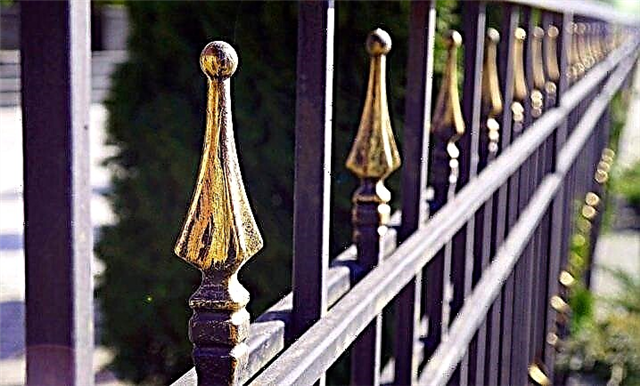
If you have the desire and relevant technical skills, you can make pick-up tips in the form of a peak with your own hands. In this case, it is necessary to use not casting or forging (this is practically impossible at home), but welding and cutting of metal. The material of manufacture will be a steel round or square rod, corner, hexagon, fittings and I-beam.
Such products, while not being sufficiently aesthetic, quite sharp at the ends and do an excellent job with the protective function. They are not inferior in strength, reliability and durability to more elegant cast and forged counterparts.

Criterias of choice
Initially, the historical function of the pointed fences was to protect the territory from unwanted intruders. The perimeter of the hedge has always been equipped with sharp elements precisely for this purpose. The aesthetic appeal and artistic sophistication of the fence faded into the background. In our time, the main significance remains with the decorative purpose of such tips. To combine these two functions, you can use the finials made of steel, made by art forging.
For decorative purposes, it is better to use cast peaks, which, unlike forged varieties, have a more blunted top.

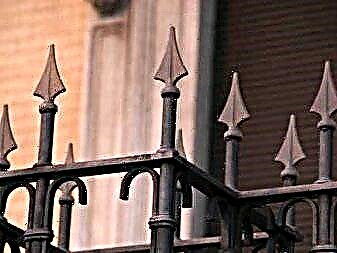
There are combined types of fences that combine pointed and decorative peaks installed through one. Another selection criterion for the intake or gate tips is the problem of the relevance of any of their varieties with respect to a particular type of construction of the fence. This especially applies to the use of cast peaks on beautifully forged fences, because for a patterned forged fence such finials can become "alien" elements.
It is important to comply with the measure, trying to achieve the originality of the fence. Peaks should be combined with the existing fence.
Features of installation and care
When setting a peak on the upper section of the fence, it is important to take into account the nuance: they must reproduce the shape of the section itself (for example, arched, wavy, flat or angular). In order to visually change the geometry of the fencing pattern, they can be folded into figures, changing by heating and bending the inclination of the ends of the rod, on which peak tops are attached.
In some cases, such elements are installed not only on the upper part of the fence, but also include them in the composition of the pattern in its middle part, or equip them with the lower cut of the fence. They must be installed. vertically, even if they are pointed down. In this case, it is permissible to install the top through one bar fence, as well as on each of its rods (provided that the distance from the poles is a certain distance).
As for the technology of fastening steel tops to the fence, forged peaks are attached to the fence by electric welding. The only parameter that should be taken into account in this case is the cross section of such a pommel, which can be either round or square. Therefore, they should be fixed to the intake elements of the corresponding profile.
Cast peaks differ from forged counterparts by the presence of a cavity in the form of a landing nest. When assembling this cavity is mounted on top of the intake profile or rod. This requires observing the principle of fastening a round profile to a round bar, and square to square.
As for the care of forged or cast fence peaks, for its implementation it is enough to periodically paint these elements in order to protect them from corrosion (with the exception of cast iron products). This will update the design of the fence, giving it a fresh and beautiful appearance.
Staining can be done in the tone of the fence, or highlighting the peaks with a contrasting color.

See how to make pickpipes in the shape of a peak with your own hands in the next video.
The main advantages of the implemented models
The peaks presented in our assortment differ:
- Long service life. The peak is resistant to numerous influences. Thanks to this, it does not lose its attractiveness even after several years of operation.
- High reliability.
- Thoughtful design. You can choose the peak corresponding to the design of the fence or other design, the architecture of the house.
- Ease of installation. Products are easily welded to fences and other structures.
Forged Peak: Technolux Benefits
- A wide range of forged products. We offer peaks of various types and sizes. You can easily pick up the necessary product for a fence, lattice, gate.
- Optimum peak value. You will not overpay for the models we sell. This is due to the fact that we work with peak manufacturers and do not make significant margins.
- Convenient product catalog. You will quickly navigate the assortment of rush and can choose the right one.
- The help of specialists. Our managers are ready to talk about the presented peaks and provide support when placing an order.
- Prompt delivery. Any peak can be brought to you as soon as possible.
Contact! Any peak will be an excellent finishing decor for any fences, railings, and other designs.
How to choose the peaks
Many people believe that cast peaks are the property of only expensive fences, although in reality this is not so. Such an opinion was widespread due to the fact that the forged fence itself costs a lot of money, as well as the peaks to it. Therefore, many people who want a decent fence, have to choose from cheaper options, most often stopping at the metal profile.
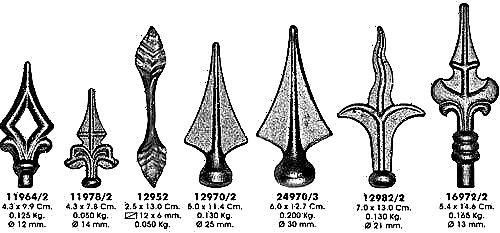
Sizes and shapes options for fence peaks
Since a forged fence can consist of both round shaped pipes and square pipes, it is important to consider this when buying a peak. Also pay attention to the diameter of the cross section: the peak parameters should be slightly large so that they harmoniously settle at the top, covering the ugly ends of the fence.
An equally important parameter is the quality of the derived material. Cheaper options are usually made of less durable metal, which will subsequently affect operation.
Therefore, it is recommended to choose only forged cast peaks, strong enough and durable, they can protect their owners from unwanted intrusions at any time. Do not forget that the peaks should fit into the exterior of not only the fence, but also the yard as a whole. Therefore, select the tops so that they complement the image, and do not violate the integrity of the composition with their overly threatening appearance.
The price of products depends not only on such a parameter as quality, but also on the complexity of the decorative device. The more curls and small parts that take longer to produce, the more expensive the peak. Buying peaks separately is not a problem, but most manufacturers offer fence panels, which initially have pointed decorative elements that perform protection functions.
Varieties of rush
Many people believe that peaks are exclusively spiky tops, but this is not entirely true. There are several types of peaks:
- In the form of a peak of arrows,
- In the shape of flattened petals,
- Sharp end cones and pyramids,
- Decorative figurines.
According to their texture, the peaks can be both voluminous and flat. Their price completely depends on this indicator. You can buy peaks in specialized stores or directly from the manufacturer. Often there are situations when it is simply impossible to buy what you want, or fit perfectly into the exterior, in the store. In this case, you can go to the factory and order such peaks that are right for you, in compliance with measurements and personal wishes.

A selection of different types of fence peaks and other forged elements
Peaks can be established not only at the tops of fences, but also at the bottom of them, emphasizing the seriousness of intentions and the impossibility of penetrating inside. This is convenient because over time, sagging soil increases the distance between the bottom of the fence and the surface of the earth, giving more chances for the penetration of detractors.
Forged metal peaks
If these peaks are to your liking, the installation will be simple. To do this, you need to have skills in working with the welding machine. To facilitate the process, you will need a stepladder, as well as the help of a friend.
If you had to buy peaks without measuring and taking into account the cross-sectional shape, the DIY installation process will be much more complicated. The output may result in a not quite even and harmonious top, which will differ from what was intended. Therefore, before you buy the first samples you like, be sure to pay attention to the technical parameters.
Wood peaks
Wooden peaks are screwed with screws to the top of the fence, after which they must be opened with varnish. Most often, those who want to get a wooden fence with peaks have to order them together with the fence, since separate manufacture and installation often cause a number of complications.
DIY peaks
Unable to buy what you like, you can make peaks with your own hands from a tree or metal profile.
Wood peaks
In order to build wooden peaks for the fence, you will need the following tools:
- Wooden beam
- Jigsaw (you can take an electric one),
- Sandpaper,
- Ruler and pencil.

So, in order to give a zest to the wooden fence and diversify the appearance that has bothered over many years of use, you can cut pointed peaks from the beam. We take a wooden beam and use a ruler and a pencil to mark the future peaks.
For beginners, you can use the simplest motifs, and for those who have been familiar with such work for a long time, you can take curly stencils, the complexity of cutting which is higher.
It is worth noting that the marking is not applied to the end of the beam: 1/3 of its length is left for fastening with a fence. When the drawing is applied, you can start cutting the peak with your own hands. To do this, take a jigsaw on a tree and first cut out the largest parts, then those that are smaller. In this case, it is better to fix the wooden blade to the surface so that the jigsaw does not change its path during cutting.

Beautiful patterns for the peak of wood
Features
Peaks are only suitable for forged fences. Great variety of appearance, but most often use flattened metal petals. Cones with three or four sides are quite widely used.simulating the tip of a spear or arrow. You can make these simulations both textured and flat.
Along with this, the details of the forged barriers, reproducing an elongated triangle with equal sides, show themselves quite well.
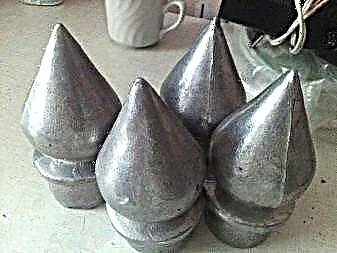



"Fir-trees" or simulated figurines can look very elegant. As for the material, the advantage of the cast-iron top is its impressive variety, and the weak point is the insufficiently effective fixation on the steel fence.
Cast iron peaks are initially more decorative than protective. Steel elements for the fence are easily attached to steel bases and are sharp enough to reliably block intruders.




The combined version, when sharp and decorating peaks follow alternately, allows you to confidently solve both problems as efficiently as possible.
The choice of a specific type of peak is also determined by their relevance in a particular case, for example, cast tops of the fence are unacceptable on a beautiful forged barrier, where they will look unnatural.

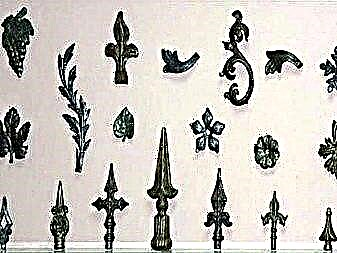
Recommendations for use
Decorative elements can be placed on the upper parts of the hedges, and below. Tops mounted at various heights in the form of waves or semicircles make it possible to create a slightly rounded fence. This step helps to correct the insufficient height of the sections, if you build up the canvas both from above and below.
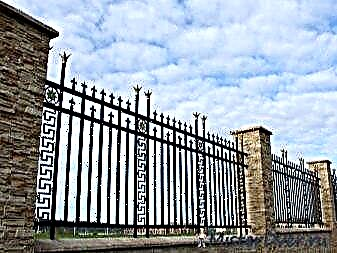

Peaks are always fastened by welding, it is better to use parts of the same cross section and shape with metal rods.
Models
On forged fences, peaks with an internal cavity are most often placed; fabrication from steel allows the metal to be painted, varnished and decorated in any other way.
In addition to forging, profile jewelry also performs well. To get them, a steel sheet is cut into pointed tips, and these blocks are mounted on top of the fence. Although such a solution began to be applied only some time ago, it is easy to install, all the work can even be done with your own hands.

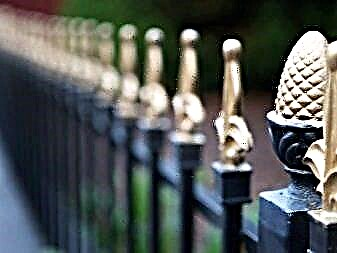

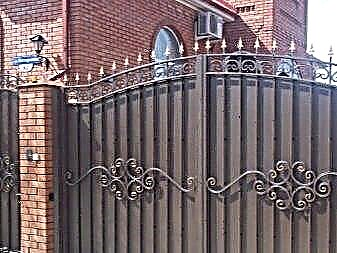
In some cases wood peaks can be usedwhich give the type of stockade to the fences, such blocks are installed as tops, and they may not form a monolithic composition with the fence itself. For the manufacture of wooden structures using carpentry machines.

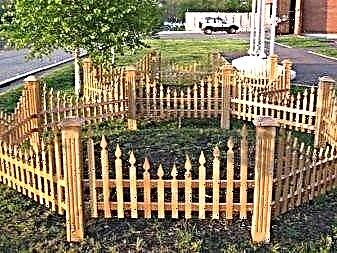
Selection tips
Most consumers are dominated by the stereotype that cast metal peaks are very expensive. Most likely, such representations are caused by the high cost of forged fences and decorations for them. The conclusion is simple: products from the profile are much more economical, and it is them that must be chosen for the sake of maximum savings.
But if you still have the opportunity to buy forged barriers, you need to focus primarily on the geometric configuration of the peak. These elements should be larger in cross section than the main details of the fence, because otherwise the location on the top is not harmonious enough, and the poor-looking ends of the fences will be open.
It is recommended to find out what specific material the peaks are made of. If they are cheap, it is likely that a bad metal is used, which will quickly fail and not be strong enough.

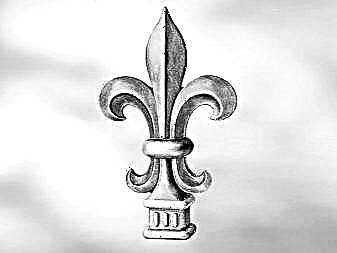
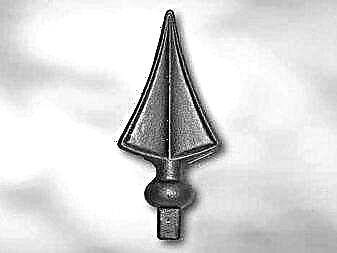

When choosing the appearance of decorative products, you need to be interested in their compatibility not only with the fence, but also with the courtyard, the house and the street as a whole. Think about the quality of the image and the consistency of its parts.
The cost of construction is directly proportional to how complex its configuration is.: each curl, each small detail and a small fragment increase the cost of work and the amount of expendable material.
In order not to select the appearance of the structure, it is advisable to use fence panels in which there are decorative parts installed by the manufacturer with sharp ends. Their protective properties are quite large.
If you can’t choose the right solution among the serial products presented in stores or in catalogs, you can always make an individual order - the quality and price will be no worse in this case.

Installation
Metal peaks must be installed using a welding machine, step ladders help to simplify and facilitate the process. It is advisable to do work together with a partner, as this greatly improves the result, and also makes the process safer. When the peaks are selected taking into account the exact dimensions and geometry, it is not difficult to mount the tops with your own hands.
If these requirements are not met, the risk is high that the resulting design will not be harmonious enough.
Attention: cast peaks by technology can not only be welded, but also simply installed on the base of the rods.
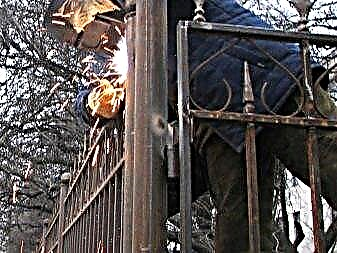
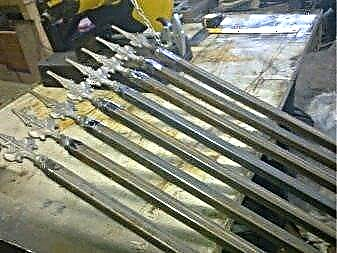
Peaks made of wood are held on the upper parts of the fences with self-tapping screws, they are certainly covered with a layer of protective varnish. In most cases, the fence itself and wooden decorations for it are ordered at the same time at the same company, since otherwise many problems can arise.

Do it yourself
Wooden peaks are made relatively simple, the main tool in the work is a jigsaw (regular or electric). It is recommended to draw in advance on paper a diagram of the future barrier and its decor in order to avoid possible errors and miscalculations.. Pointed elements are cut from a conventional beam in accordance with the marking.
Note: for inexperienced people it is better not to resort to decorative delights, but to limit yourself to the simplest and most affordable solutions. Later, when the experience appears, it will always be possible to change the initial peaks to those made on complex stencils.


Note that you do not need to mark out the entire beam, about a third of it remains in reserve - it is needed for subsequent consolidation. Saw details should be as they decrease, and the blade should be thoroughly fixed so that the jigsaw moves as clearly and predictably as possible. The edges of the blanks are cleaned to a perfectly even state with sandpaper.
Self-made forged rush is impractical, professional performers will do the same work more quickly and better. An alternative is the use of a profile sheet of metal, which is marked with a marker and cut along the lines with special scissors.
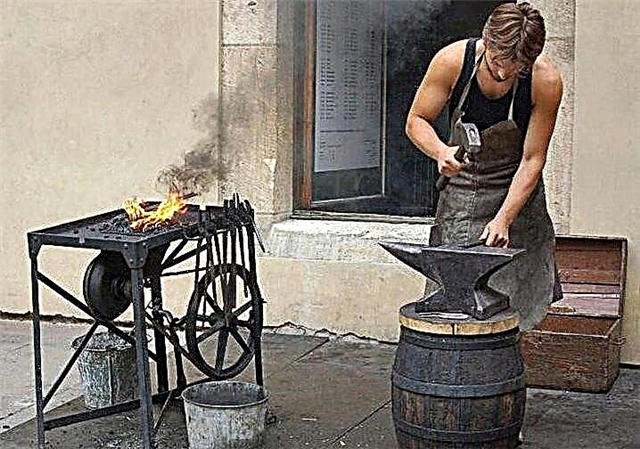
It should be noted that the plastic tops offered by a number of companies are quite reliable and modern.
Such accessories are universal, look organically and on forged and made of a metal profile, and even on wooden fences. In any case, the shape of the cut should correspond to the cut of the fence. Plastic structures are more decorative than helping protect the house and yard.
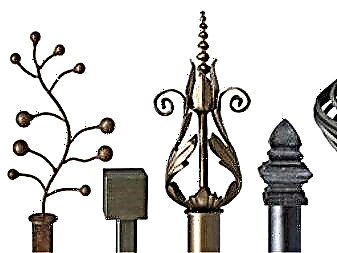
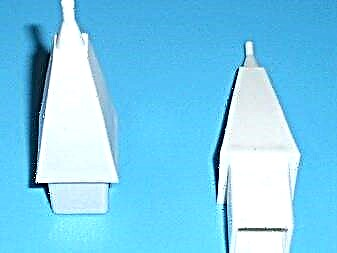
On how to make forged peaks with your own hands, see the following video.



